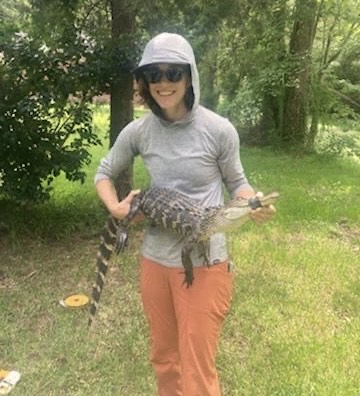Reptilian Red Flags: Forever Chemicals Found in Alligators in North Carolina Waters

Using powerful instruments, UNC researchers, including Anna Boatman, above, and Associate Professor Erin Baker, uncovered dozens of per- and polyfluoroalkyl substances (PFAS), including two entirely new compounds, circulating in the blood of alligators. photo credit: Kylie Rock
June 3, 2025 I By Dave DeFusco
In the tannin-dark waters of North Carolina’s Cape Fear River, the American alligator—ancient, armored and apex—may seem an unlikely ally in the fight against invisible chemical pollution, but thanks to cutting-edge technology and a five-year research effort, scientists at UNC-Chapel Hill, Clemson University and North Carolina State University have turned these prehistoric reptiles into unlikely sentinels of environmental health.
Using a powerful combination of liquid chromatography, ion mobility spectrometry and high-resolution mass spectrometry, the researchers, including UNC Ph.D. chemistry students Anna Boatman and and Gregory Kudzin, and Associate Professor Erin Baker, have uncovered dozens of per- and polyfluoroalkyl substances (PFAS)—including two entirely new compounds—circulating in the blood of alligators.
“We’re entering a new chapter in PFAS detection,” said Dr. Baker. “These chemicals are so chemically diverse that traditional methods cannot keep up. Our non-targeted approach allowed us to go beyond what we already knew was there—and what we found was surprising.”

PFAS are a sprawling family of human-made chemicals prized for their water- and grease-resistant properties. Found in products ranging from nonstick cookware to firefighting foam, PFAS have earned the nickname “forever chemicals” for their near indestructibility. While a handful of PFAS compounds, like PFOA and PFOS, have been studied extensively and regulated recently, thousands of lesser-known variants remain unmonitored, unregulated and largely unknown.
In their study, “Novel PFAS in Alligator Blood Discovered with Non-Targeted Ion Mobility Spectrometry-Mass Spectrometry,” published in the journal Science of the Total Environment, the research team analyzed plasma samples from 198 alligators collected between 2018 and 2022 in three regions: Cape Fear River, a polluted waterway downstream from a fluorochemical manufacturing facility; Lake Waccamaw, a nearby North Carolina reference site with no known PFAS point sources; and Florida’s St. Johns River, hundreds of miles from any fluorochemical plant.
“Alligators have long lifespans and sit at the top of the food chain, which makes them excellent sentinels for chemicals like PFAS,” said Boatman. “Their high level of exposure gives us a better chance of finding PFAS that build up in their bodies and what chemicals might be accumulating in other parts of the ecosystem, including people.”
Using their sophisticated LC-IMS-HRMS platform, the researchers identified 46 PFAS in alligator blood, including 34 known PFAS, three never before reported in environmental media and two brand-new compounds previously undocumented anywhere.

“Non-targeted analysis is like going into a dark room with a flashlight and suddenly discovering furniture you didn’t know was there,” said Kudzin. “Our discovery workflow helped us find compounds we never could have targeted directly because we didn’t know to look for them.”
Among the standout discoveries were two H-substituted polyfluorinated triether acids, nicknamed Compound 628 and Compound 592. Structurally, these molecules include a rare hydrogen substitution for fluorine, making them highly unusual and hinting at a previously unrecognized chemical class.
“Several of the PFAS we found haven’t been seen in wildlife before,” said Boatman. “Almost all of the alligators from the Cape Fear River had detectable amounts of these novel chemicals, which is really concerning because nobody has been looking for these PFAS in water or in people.”
The contrast between alligator populations was striking. More PFAS were found in North Carolina alligators than in Florida’s, and the novel compounds were exclusive to the Cape Fear River gators. Perhaps more unsettling: the amount of PFAS in North Carolina alligators did not change over five years, despite growing public awareness and increased regulation.
That stagnation suggests either continued environmental release or legacy contamination—chemicals remaining in the water and sediment for years, slowly making their way up the food chain.
“It’s a sobering result,” said Dr. Baker. “Despite efforts to reduce PFAS emissions, we’re still seeing high and stable levels in wildlife. These animals are living with the consequences of decades of pollution, and they’re telling us we haven’t fixed the problem yet.”
While humans and alligators differ in obvious ways, they share the same water sources—and many of the same physiological vulnerabilities. Past studies have linked PFAS exposure in alligators to immune dysfunction, including unhealed wounds and elevated autoantibodies. Those effects raise red flags for potential human health risks and the presence of novel PFAS adds a new layer of concern.
“These aren’t just scientific curiosities,” said Kudzin. “Each unidentified or unmonitored PFAS is a gap in our understanding of what we’re being exposed to. The goal is to close those gaps. We need comprehensive, long-term monitoring not only in water, but in biological organisms. Otherwise, we risk missing key pieces of the puzzle—pieces that could affect public health.”
The team’s findings underscore the power of non-targeted analysis in environmental chemistry. By moving beyond the “usual suspects,” researchers can uncover new threats—and new opportunities for regulation and remediation. Boatman is already planning follow-up studies, including additional sampling and collaborations with toxicologists to better understand how these novel PFAS behave in living systems.
“It’s really important to keep doing these studies,” she said. “There’s so much we don’t know, and industry deregulation is only going to make the problem more complicated. But there are a lot of researchers out there who care about protecting the health of people and our environment, and we’re trying our best to put good science out there and hopefully make a difference.”

